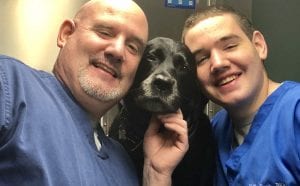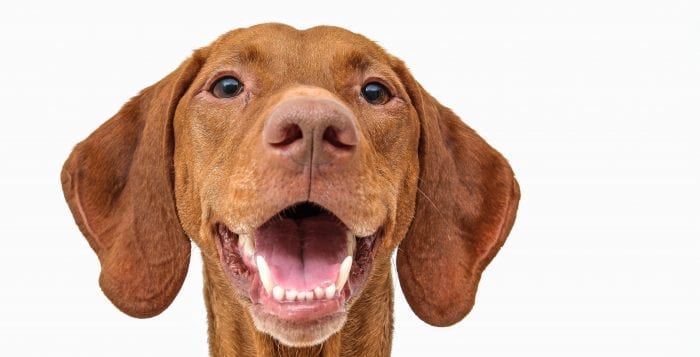Ask the Vet: Home dental care for your pet
By Matthew Kearns, DVM
 When I bring up dental procedures with pet owners, the concern is pets require anesthesia for dental work. That invariably brings the question, “Is there anything we can do at home to prevent this?” The answer is a resounding “YES!!!”
When I bring up dental procedures with pet owners, the concern is pets require anesthesia for dental work. That invariably brings the question, “Is there anything we can do at home to prevent this?” The answer is a resounding “YES!!!”
First, I would like to briefly review the pathology of periodontal disease. Dogs and cats do not suffer from dental disease as much as humans. They suffer from periodontal disease.
Dental disease refers to pathology with the tooth itself: caries, cavities, etc. Periodontal disease refers to pathology of the structures around the tooth: gingiva (gums), the periodontal ligament, perialveolar bone.
Periodontal disease begins with plaque. It has been proven that even within 24 hours of a professional cleaning, a thin film of bacteria, saliva and food (also known as plaque) accumulates on the enamel of the tooth. Plaque that is not removed mineralizes within 10 days into tartar or a calculus. Once tartar takes hold a shift develops from aerobic bacteria (bacteria that need oxygen to survive) to nasty anaerobic bacteria (those that need little or no oxygen to survive). Anaerobic bacteria secrete toxins that inflame the gums and lead to small abscesses or pockets under the gums. Bacteria start to destroy the support structures around the tooth which is very painful. If not treated then the tooth will need to be removed.
Brushing: Brushing the teeth removes this film before it has a chance to mineralize. If you do decide to brush your pet’s teeth first pick a toothbrush and toothpaste that is veterinary approved. We humans know to rinse and spit when done brushing, but our pets do not. Swallowing human toothpaste is harmful because it has too much sodium, fluoride and is sweetened with saccharin.
Pet-safe toothpaste comes in a variety of flavors that pets will like (chicken, beef, fish, etc.) better than good old-fashioned fresh mint. When you first begin just put a little toothpaste on the end of the brush and let your pet investigate. If they sniff, lick or even just chew on the brush that is fine. Then start by gently just brushing the front teeth. Once they tolerate that, start to work toward the back teeth.
Dental Treats/Diets: Effective brushing of your pet’s teeth needs to be done daily (at least four times per week) and scheduling time to brush your pet’s teeth can be difficult. I have yet to meet an owner able to teach his or her dog/cat to brush their own teeth. Certain prescription diets (Hill’s t/d® and Purina Pro Plan DH®) literally clean the teeth as your pet eats. There are also treats that do the same. Look for the Veterinary Oral Health Council (VOHC) seal on the packaging. If you can’t find a VOHC-approved treat, remember this slogan, “If you wouldn’t want to get hit in the knee with this dental treat, don’t let your pet chew on it.” That means if it is too hard your pet runs the risk of damaging their teeth.
Rinses: Again, look for the VOHC seal of approval. The safest and most effective rinses contain chlorhexidine. Chlorhexidine is most effective against the development of plaque, and chlorhexidine-based rinses are considered the gold standard of veterinary oral rinses. Rinses containing xylitol, or fluoride, should be avoided in my opinion because of their potential for toxicity.
This is not a complete list of dental home care products so, as always, please consult with your own veterinarian for a more in-depth conversation. In addition, I can’t guarantee that even if you follow through with all these recommendations that your dog or cat will not need professional dental care (including extractions), but it certainly helps. Remember, BIG SMILES!!!
Dr. Kearns practices veterinary medicine from his Port Jefferson office and is pictured with his son Matthew and his dog Jasmine. Have a question for the vet? Email it to [email protected] and see his answer in an upcoming column.







